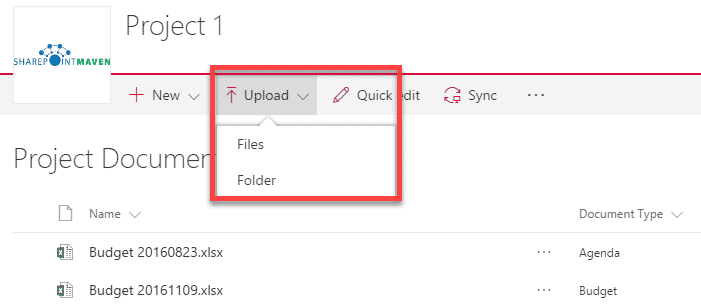I had an interesting and trivial question being asked the other day by one of my clients. “How do I save files to SharePoint?” I almost responded, “You must be kidding.” I thought, just like breathing and eating – this was intuitive and common knowledge. But then, as I was explaining the options, I realized that there are way too many techniques to save files to SharePoint, each with its pros and cons. So, to answer my clients’ question and for my own sanity, I decided to write this post and document all the options for you. Here we go.
Method 1: Upload Button
The most basic and intuitive option would be to use the Upload button on the library. For those who are in SharePoint Online, you can upload multiple files and folders. Those living with older versions of SharePoint or those who run SharePoint on-premises or those still running classical look and feel of a document library – you can only upload one file at a time using this method.
Image may be NSFW.
Clik here to view.
Method 2: Drag and Drop
This is the new feature that became available with SharePoint Online/SharePoint 2013. The convenience factor here is that you can drag and drop multiple files and folders from any location right onto your browser. Please note that just like with previous option, you cannot drag and drop folders unless you have SharePoint Online and use modern experience for a document library.
Image may be NSFW.
Clik here to view.
Method 3: Save As from Word, Excel, PowerPoint
If you are authoring a brand new document in Word, Excel, PowerPoint or OneNote, you can save documents directly to a specific SharePoint site/library. This might prove very convenient, as you don’t need to save a document to the desktop first and then upload to SharePoint, eliminating an unnecessary step.
Here is how you do this:
- Copy the URL of a SharePoint site you want to save a document toImage may be NSFW.
Clik here to view.
- From Word, Excel, PowerPoint or OneNote, do File > Save As > Browse. In the window that pops up, paste the URL of the SharePoint Site in the address window. Make sure to not include the full path though. For example, if your site address is https://companyname.sharepoint.com/sites/intranet/accounting/SitePages/Home.aspx, only paste the part up to /Sites/Home.apsx (https://companyname.sharepoint.com/sites/intranet/accounting). Otherwise, it won’t resolve, and you will get an error message.Image may be NSFW.
Clik here to view.
- Once you do the above, you will see contents of the site. So just navigate to a library and specific folder where you want to save a document to and click OpenImage may be NSFW.
Clik here to view.
- The document is now saved directly to SharePointImage may be NSFW.
Clik here to view.
NOTE:
In Step 2 above, you could also paste the URL of a document library itself, not the whole site. However, just like described in Step 2 above, make sure to paste the URL of a library itself, do not include the path to a specific view. For example, if the full path to a library/view is https://companyname.sharepoint.com/sites/intranet/accounting/Shared%20Documents/Forms/AllItems.aspx, the path you need to paste in the address bar of the pop-up is https://companyname.sharepoint.com/sites/intranet/accounting/Shared%20Documents (without /Forms/AllItems.aspx).
Otherwise, the location will not resolve, and you will get below error message:
Image may be NSFW.
Clik here to view.
Method 4: Create new Office Online document
Another way to save files to SharePoint is to create them from SharePoint! Image may be NSFW.
Clik here to view. Instead of creating new documents in Word or Excel on your desktop, you can use the “New” drop-down button and choose the file you want to create. You can choose from Word, Excel, PowerPoint and OneNote.
Instead of creating new documents in Word or Excel on your desktop, you can use the “New” drop-down button and choose the file you want to create. You can choose from Word, Excel, PowerPoint and OneNote.
Image may be NSFW.
Clik here to view.
The beauty of this method is that files created this way are getting automatically saved into the document library/folder where you clicked the “New” button from! Moreover, no need to be paranoid about hitting the Save button – document is auto-saved for you, courtesy of Office Online capabilities.
Image may be NSFW.
Clik here to view.
Method 5: Upload via Windows Explorer (File Explorer)
Another option for you to save files to SharePoint is via Windows Explorer. When you open a document library via Windows Explorer, it opens up a regular File Explorer window, and you can drag and drop your documents and folders, just like you are moving/copying files in Windows. This is not my favorite option, and I actually published a post on why you no longer need this. You might resort to this option only if you have a classical document library, run SharePoint on-premises or have non-Microsoft Office files (i.e. AutoCAD or Photoshop files). If you use modern library experience, use any of the above options instead.
Image may be NSFW.
Clik here to view.
Method 6: Upload via OneDrive Sync Client
Another option for you to save the files to SharePoint is by using OneDrive sync client. What that means is that you Save your files to the OneDrive sync folder on your C: drive, to a previously synchronized document library and the sync does the rest by syncing (copying) the files to SharePoint Online. To read more about this feature – click here.
Image may be NSFW.
Clik here to view.
Other options:
Peter Kalmström of kalmstrom.com Business Solutions has a great video describing some of the above options + few additional ones, so feel free to check out his post here.
The post 6 ways to save files to SharePoint appeared first on SharePoint Maven.



